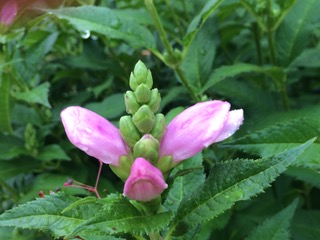Pam Haze
Adams County Master Gardener
 (9/12) Among the many plants you might consider adding to your garden is a native perennial herb that is one of my favorites - turtlehead. The plant is hardy, attractive, colorful, long blooming, and requires little maintenance. At this time of the year when many plants have finished flowering, it provides a bright spot in the garden and is a source of food for hungry pollinators. The flower, true to its name, looks like the head of a turtle and when it blooms the petals separate like a turtle’s beak opening. It is a favorite for bumble bees and each year I look forward to watching them foraging in the flowers.
(9/12) Among the many plants you might consider adding to your garden is a native perennial herb that is one of my favorites - turtlehead. The plant is hardy, attractive, colorful, long blooming, and requires little maintenance. At this time of the year when many plants have finished flowering, it provides a bright spot in the garden and is a source of food for hungry pollinators. The flower, true to its name, looks like the head of a turtle and when it blooms the petals separate like a turtle’s beak opening. It is a favorite for bumble bees and each year I look forward to watching them foraging in the flowers.
Turtlehead blooms are numerous and long-lasting. Flowers form on dense spikes carried above the foliage and begin to open in mid-to-late August lasting into September. The plant grows from individual, strong stems that multiply and increase in size over time, forming a 3-4 foot-tall and 3-4-foot-wide clump that resembles a medium-sized shrub. Leaves are lanceolate, serrated, and opposite. Even when not in flower, the plant is attractive with lush foliage and clustered buds that form a pyramid atop each stem.
There are four species: pink turtlehead, Chelone lyonii; white turtlehead, Chelone glabra; red turtlehead, Chelone oblqua; and Cuthbert’s turtlehead, Chelone cuthbertii, which has purple flowers. Chelone means turtle in Greek. In Greek folklore Chelone was a mountain nymph who did not attend the marriage of Zeus and Hera, the king and queen of the gods. In retribution the gods turned her into a turtle and condemned her to wear her house on her back.
Turtlehead is part of the plaintain family, Plantaginacea and is closely related to snapdragons, foxglove, hyssop, beardtongue, and culver’s root. It is found throughout most of the eastern United States along stream banks and in boggy areas. Cuthbert’s turtlehead is more restricted in its range and can be found in Georgia and Florida.
The plant has long been used, beginning with native peoples, as a source of natural medicine including a tonic to benefit indigestion and a salve for itching and inflammation.
Turtlehead is a great addition to a bog garden, rain garden, pollinator, or wildflower garden because it attracts bumble bees, butterflies, and other insects and hummingbirds. With its long blooming time, it provides a wealth of pollen and nectar for pollinators. White turtlehead, Chelone glabra, is a host plant for the Baltimore checkerspot butterfly. The bitter tasting foliage is not attractive to deer or rabbits. Stems can be cut for arrangements and will last about a week in water.
Turtlehead can be grown in a moist, partially shaded garden with ease. It provides a striking backdrop to perennials and annuals. During periods of extensive drought, the plant will need watering – the wilted leaves will signal that it is time to water. It is hardy in our growing zone 6b. It prefers slightly acidic, organically rich soil, but tolerates the neutral to basic, clay soil we have here in Adams County. An annual dressing of compost and/or mulch will keep the plant healthy and looking good.
It is not necessary to deadhead turtlehead, instead you can leave the flowers to dry and collect the seeds or allow the plant to self-seed. Pinching back the stems early in the season will reduce the height of the plant and promote denser growth. You can reduce the size of the clump by pulling out individual stems and you can increase the number of plants by dividing them in early spring when the new growth emerges. It can also easily be grown from seed, sown directly in the soil, or started indoors. Chelone does not seem to be bothered by insects or disease. It can develop powdery mildew if it does not get enough sun, but I’ve not had this problem.
For the last several years I’ve have had great success growing pink turtlehead in a garden bed that faces north. The bed stays moist most of the time, is in shadow for the early part of the day and gets lots of sun in the afternoon. The plants in this bed are glossy green with lots of flowers and they come back bigger and more robust each year. They’ve stood up to high winds and pummeling rains and still look great. This year I began to grow white turtlehead in this same bed. It is not as robust in appearance as the pink turtlehead. The leaves are slenderer, a lighter shade of green and are not glossy. The stems are taller, not as sturdy and a bit lanky as compared to the pink turtlehead. I’m also noticing dark spots from fungus. But because it’s been a challenging year to start new plants with high temperatures and long periods without rain, I am hopeful that they will come back next year looking better.
All in all, the turtlehead has turned out to be a great addition to my garden. If you have the right conditions for this plant, I hope you will try to grow turtlehead in your garden.
Read other articles by Pam Haze